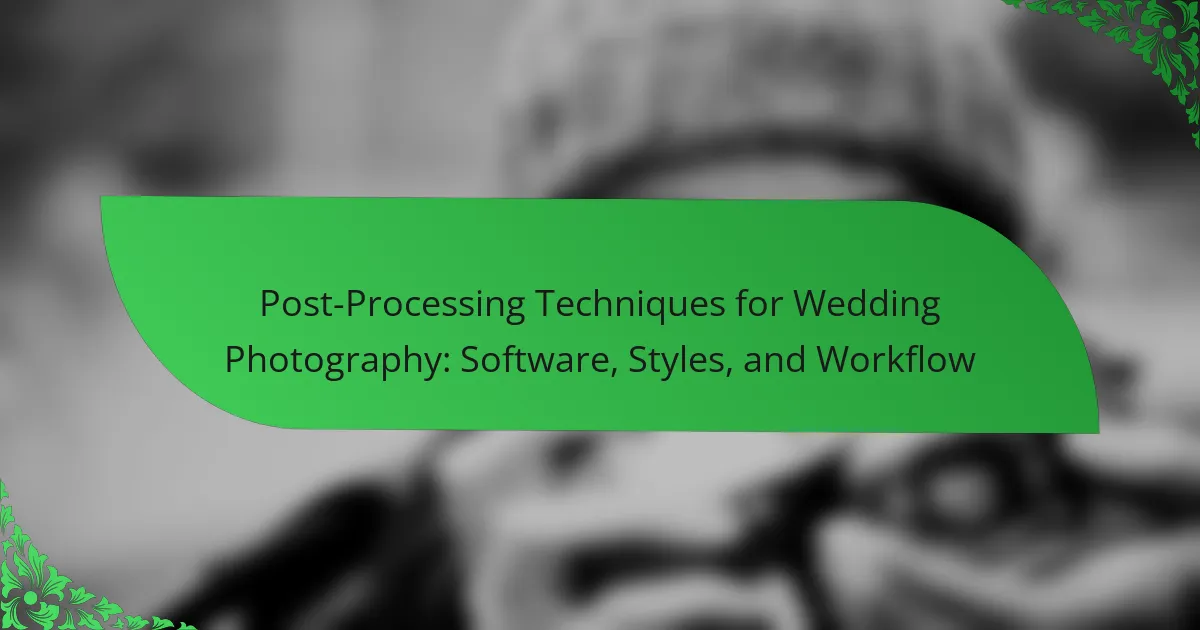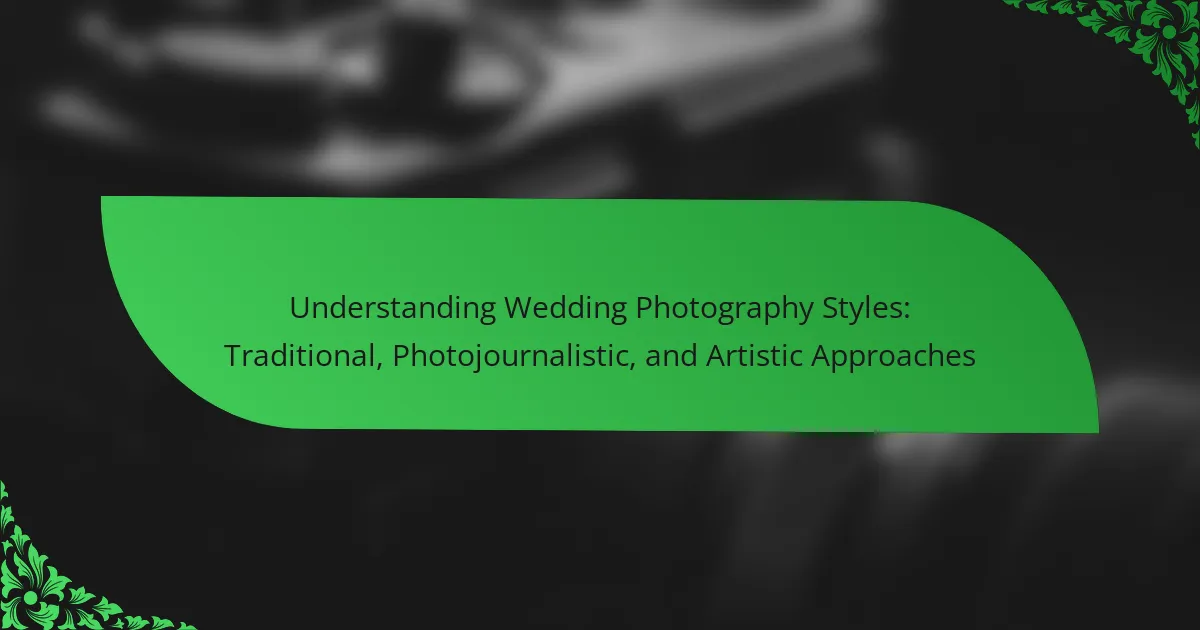Post-processing techniques in wedding photography enhance and finalize images after capture, encompassing methods such as color correction, cropping, retouching, and applying filters. These techniques are crucial for producing high-quality wedding albums that align with client expectations. Popular post-processing styles include light and airy, dark and moody, and vintage, each influencing the emotional impact of the photographs. The typical workflow involves importing images into editing software, selecting the best shots, making adjustments, and delivering the polished final product. Utilizing professional editing software and developing a consistent editing style are essential for improving post-processing results.
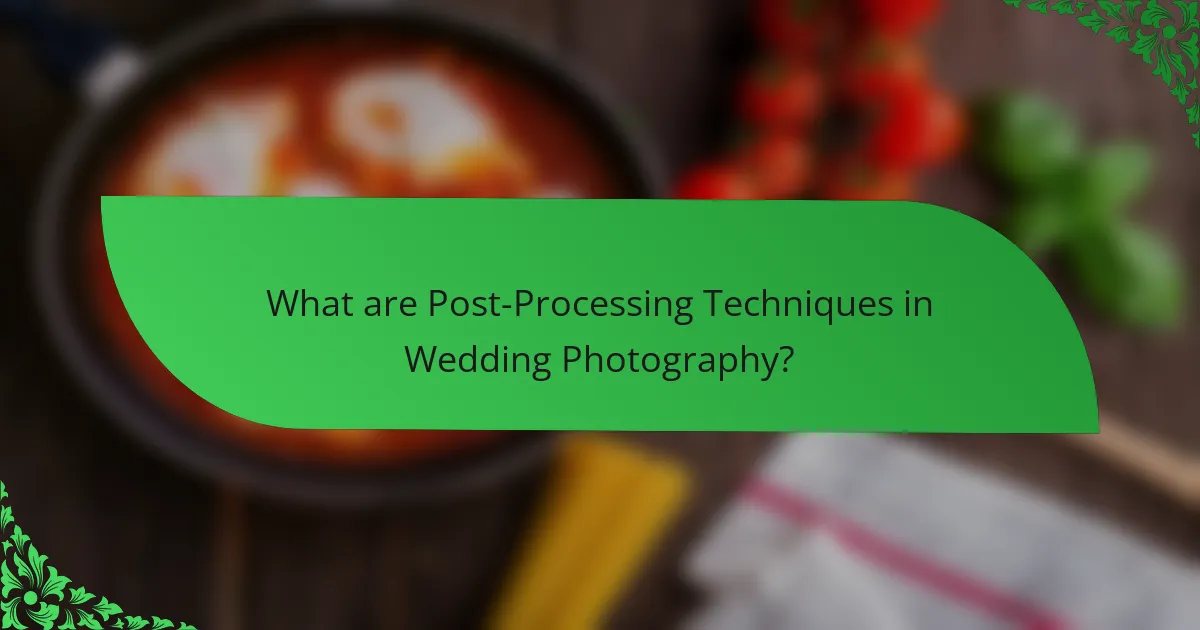
What are Post-Processing Techniques in Wedding Photography?
Post-processing techniques in wedding photography refer to the methods used to enhance and finalize images after they have been captured. These techniques include color correction, cropping, retouching, and applying filters. Color correction adjusts the overall tone and balance of the images. Cropping helps to improve composition and focus on key elements. Retouching removes imperfections and enhances features in portraits. Applying filters can create a specific mood or style for the images. These techniques are essential for producing high-quality wedding albums that meet client expectations.
How do these techniques enhance wedding photographs?
Post-processing techniques enhance wedding photographs by improving image quality and aesthetics. These techniques can correct exposure, adjust colors, and sharpen details. For example, software like Adobe Lightroom allows photographers to fine-tune brightness and contrast. This results in more vibrant and true-to-life colors. Techniques such as retouching can remove distractions and blemishes, creating a polished final product. Additionally, applying filters can create a specific mood or style that resonates with the couple’s vision. Research indicates that well-executed post-processing can significantly increase viewer engagement and emotional response to wedding images.
What are the most common post-processing techniques used?
The most common post-processing techniques used in wedding photography include color correction, exposure adjustment, cropping, and retouching. Color correction enhances the overall color balance and ensures skin tones are natural. Exposure adjustment fixes brightness and contrast issues that may arise from varying lighting conditions. Cropping helps to improve composition and focus on key subjects. Retouching removes blemishes and distractions, enhancing the overall quality of the images. These techniques are essential for creating polished and professional wedding photographs.
How do these techniques vary based on photography styles?
Post-processing techniques vary significantly based on photography styles. For example, traditional wedding photography often emphasizes natural colors and soft lighting. Techniques like color correction and gentle retouching are commonly used. In contrast, documentary wedding photography focuses on authenticity and storytelling. Here, minimal editing is preferred to maintain the raw emotions captured.
Fine art wedding photography employs creative post-processing techniques. This style often includes artistic filters and heavy color grading to create a unique visual narrative. Additionally, black and white photography relies on contrast adjustments and tonal balancing to enhance mood and drama.
Each photography style dictates specific post-processing approaches to align with its artistic vision. The choice of software also plays a role, with some styles favoring Lightroom for its batch editing capabilities, while others may prefer Photoshop for more detailed manipulation.
What software is commonly used for post-processing in wedding photography?
Adobe Lightroom is commonly used for post-processing in wedding photography. It offers comprehensive tools for organizing and editing images. Photographers appreciate its user-friendly interface and batch processing capabilities. Adobe Photoshop is also widely utilized for detailed retouching and compositing. Capture One is another popular choice, known for its color grading features and tethering options. These software programs are industry standards among wedding photographers. They provide essential functionalities that enhance the overall quality of wedding images.
What are the key features to look for in post-processing software?
Key features to look for in post-processing software include user-friendly interface, editing tools, and file format support. A user-friendly interface allows photographers to navigate the software easily. Comprehensive editing tools, such as color correction and retouching options, are essential for enhancing images. Robust file format support ensures compatibility with various image types, including RAW files. Additionally, batch processing capabilities can save time by allowing multiple images to be edited simultaneously. Integration with other software or plugins can enhance functionality. Finally, cloud storage options provide secure access and backup for projects. These features collectively improve workflow efficiency and image quality in wedding photography.
How do different software options compare in terms of usability?
Different software options vary significantly in terms of usability. User interfaces can differ greatly among programs like Adobe Lightroom, Capture One, and Photoshop. Lightroom is known for its intuitive design, which simplifies photo organization and editing. Capture One offers advanced tools but has a steeper learning curve. Photoshop provides extensive editing capabilities but may overwhelm beginners due to its complexity.
According to a 2022 survey by Photography Life, 65% of users prefer Lightroom for its ease of use. In contrast, 30% favor Capture One for its powerful color grading features, despite the learning curve. User feedback consistently highlights that usability impacts workflow efficiency. Therefore, the choice of software should align with the user’s skill level and specific editing needs.
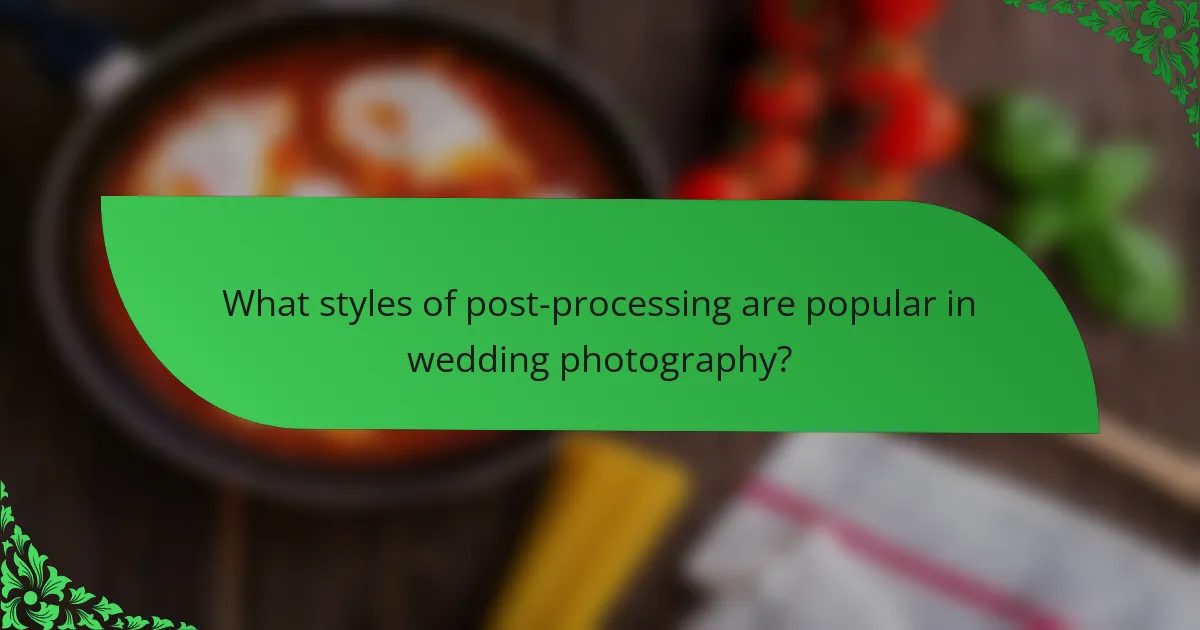
What styles of post-processing are popular in wedding photography?
Popular styles of post-processing in wedding photography include light and airy, dark and moody, and vintage. Light and airy styles emphasize bright, soft colors and a romantic feel. Dark and moody styles focus on deeper tones and dramatic contrasts. Vintage styles often incorporate faded colors and film-like textures. Each style enhances the emotional impact of wedding photos. Photographers choose styles based on the couple’s preferences and the wedding’s theme. The choice of post-processing style can significantly influence the overall aesthetic of the wedding album.
How do editing styles impact the overall feel of wedding photos?
Editing styles significantly impact the overall feel of wedding photos. Different styles evoke distinct emotions and atmospheres. For instance, a bright and airy editing style creates a light and romantic vibe. In contrast, a moody editing style can evoke drama and intimacy. The choice of color grading also influences the emotional response. Warm tones can enhance feelings of joy, while cooler tones may convey serenity. Consistency in editing style helps maintain a cohesive narrative throughout the wedding album. Research shows that viewers associate specific editing styles with particular moods. Therefore, the selected editing style shapes how the couple and their families perceive their memories.
What are the differences between light and airy versus dark and moody styles?
Light and airy styles are characterized by bright, soft colors and high exposure. These styles create a feeling of openness and freshness. They often use natural light to enhance the overall brightness. In contrast, dark and moody styles feature deep, rich colors and lower exposure. This approach evokes a sense of drama and intimacy. Dark and moody images often utilize shadows to create depth and contrast. The choice between these styles significantly impacts the emotional tone of wedding photography. Light and airy styles may appeal to couples seeking a romantic, whimsical feel. Dark and moody styles may attract those desiring a more dramatic, timeless look.
How can photographers develop their unique editing style?
Photographers can develop their unique editing style by experimenting with various post-processing techniques. They should explore different software options, such as Adobe Lightroom and Photoshop. This exploration allows them to discover tools that enhance their creative vision. Photographers can also analyze their favorite photographers’ styles for inspiration. They should take note of color grading, contrast, and composition techniques. Consistent practice is essential in refining their editing skills. Photographers should create presets that reflect their style for efficiency. Feedback from peers can provide valuable insights into their editing choices. Engaging in online photography communities can further inspire and inform their unique style development.
What role does color grading play in wedding photography?
Color grading enhances the visual storytelling in wedding photography. It adjusts the colors and tones to create a specific mood or atmosphere. This process involves modifying brightness, contrast, and saturation. Color grading can evoke emotions that align with the couple’s vision. For example, warm tones may convey romance, while cooler tones can suggest elegance. Consistent color grading also ensures a cohesive look across the wedding album. Studies show that color influences perception and emotional response. Therefore, effective color grading can significantly impact how wedding photos are received.
How can color grading enhance the emotional tone of images?
Color grading enhances the emotional tone of images by adjusting colors to evoke specific feelings. Different color palettes can convey various moods. For instance, warm tones often create a sense of comfort and happiness. Conversely, cooler tones can evoke sadness or introspection. This technique allows photographers to align the visual narrative with the intended emotional response. Research indicates that color influences human emotions significantly, affecting perception and engagement. A study published in the Journal of Experimental Psychology found that color can alter mood and emotional states. Therefore, effective color grading is crucial in wedding photography to capture the desired atmosphere.
What are the best practices for achieving cohesive color grading?
To achieve cohesive color grading, start by establishing a consistent color palette. This means selecting a set of colors that complement each other throughout the images. Use color correction tools to ensure all images have a unified tone. Adjust exposure and contrast uniformly across the series to maintain visual harmony. Utilize LUTs (Look-Up Tables) for uniformity in color grading across different shots. Pay attention to skin tones and ensure they remain consistent in all images. Finally, review the entire collection together to ensure the grading feels cohesive and balanced. Consistency in color grading enhances the overall aesthetic of wedding photography.
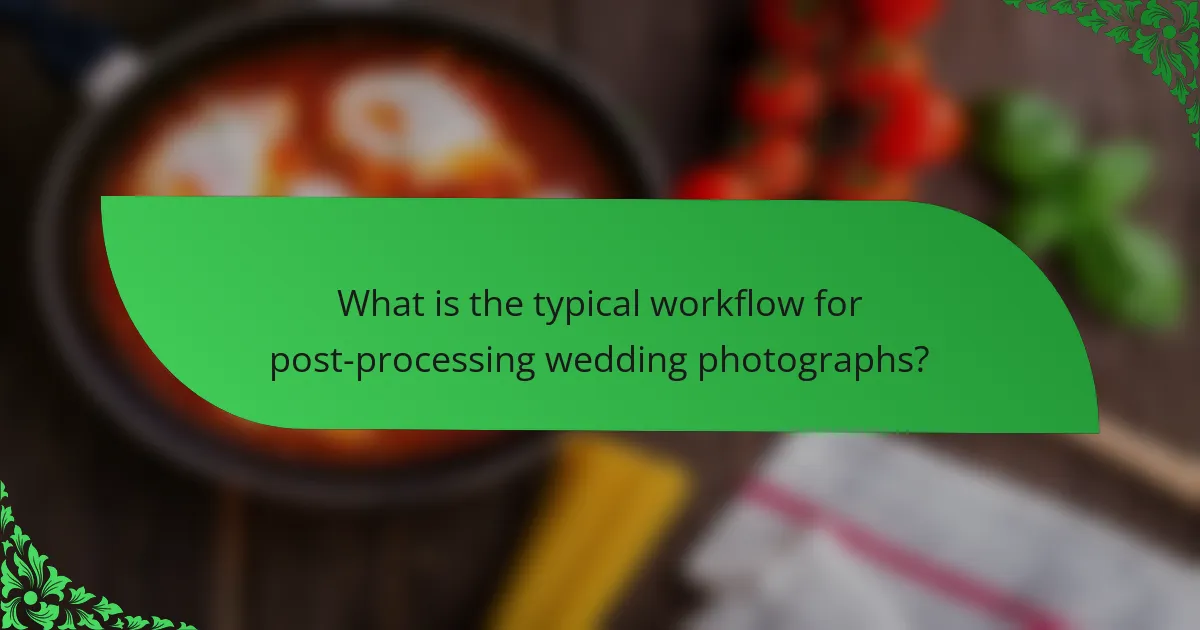
What is the typical workflow for post-processing wedding photographs?
The typical workflow for post-processing wedding photographs involves several key steps. First, photographers import the images into editing software, such as Adobe Lightroom or Capture One. Next, they cull the images to select the best shots for editing. After selection, adjustments are made to exposure, contrast, and color balance to enhance the overall look.
Following basic adjustments, photographers may apply more advanced edits, such as retouching skin imperfections or correcting lens distortion. Once the images are edited, they are exported in the desired format for delivery. Finally, the finished photographs are organized and delivered to clients, often through online galleries or USB drives. This workflow ensures that wedding photographs are polished and professionally presented.
What are the essential steps in a wedding photography workflow?
The essential steps in a wedding photography workflow include pre-wedding consultation, shooting the event, post-processing, and delivering the final images. Pre-wedding consultation involves discussing the couple’s preferences and creating a shot list. Shooting the event requires capturing key moments and candid shots throughout the day. Post-processing involves editing images using software like Adobe Lightroom or Photoshop. Finally, delivering the final images can be done through online galleries or physical albums. Each step is crucial for ensuring a smooth workflow and high-quality results.
How can organization improve the efficiency of the workflow?
Organizations can improve the efficiency of the workflow by implementing streamlined processes and utilizing appropriate software tools. Streamlining processes reduces redundancy and enhances task clarity. Utilizing software tools like Adobe Lightroom or Capture One can automate repetitive tasks. Implementing project management tools such as Trello or Asana can enhance team collaboration. Establishing clear communication channels minimizes misunderstandings and delays. Training staff on new technologies ensures they can leverage tools effectively. Regularly reviewing workflows identifies bottlenecks and areas for improvement. According to a study by McKinsey, organizations that improve their workflow can increase productivity by up to 25%.
What tools can assist in managing the post-processing workflow?
Tools that assist in managing the post-processing workflow include Adobe Lightroom, Capture One, and Photoshop. Adobe Lightroom offers powerful organization and editing features tailored for photographers. Capture One is known for its advanced color grading and tethering capabilities. Photoshop provides extensive editing tools for detailed image manipulation. These tools streamline the workflow by allowing batch processing and efficient file management. They also support various file formats, ensuring compatibility with different cameras. Each tool enhances productivity and improves the quality of the final images.
How can photographers streamline their post-processing workflow?
Photographers can streamline their post-processing workflow by utilizing software that automates repetitive tasks. Programs like Adobe Lightroom and Capture One offer batch processing features. These features allow photographers to apply edits to multiple images simultaneously. Organizing files into folders and using consistent naming conventions also enhances workflow efficiency. Creating presets for frequently used adjustments saves time on individual edits. Additionally, investing in a powerful computer can reduce processing time significantly. Using cloud storage solutions facilitates easy access to files from different locations. By implementing these strategies, photographers can enhance productivity and focus more on creative aspects.
What techniques can be used to save time during editing?
Using batch processing is an effective technique to save time during editing. This method allows photographers to apply the same adjustments to multiple images simultaneously. For example, software like Adobe Lightroom enables users to synchronize settings across selected photos. Another technique is to create and use presets for common adjustments. Presets streamline the editing process by applying predefined settings with a single click. Additionally, utilizing keyboard shortcuts can significantly speed up navigation and editing tasks. Research shows that these practices can reduce editing time by up to 50%. Overall, employing batch processing, presets, and shortcuts enhances workflow efficiency in wedding photography post-processing.
How can batch processing be effectively utilized?
Batch processing can be effectively utilized in wedding photography by automating repetitive tasks. This technique allows photographers to apply the same adjustments to multiple images simultaneously. For instance, adjustments like exposure, white balance, and color correction can be standardized across a series of photos.
Using software such as Adobe Lightroom or Capture One enhances efficiency. These programs support batch processing features that streamline workflow. According to a study by Fstoppers, batch processing can reduce editing time by up to 50%.
This capability allows photographers to focus more on creative aspects rather than time-consuming edits. Therefore, effective utilization of batch processing leads to faster turnaround times and consistent results in wedding photography.

What tips can improve post-processing results for wedding photographers?
To improve post-processing results for wedding photographers, utilize professional editing software. Programs like Adobe Lightroom and Photoshop offer advanced tools for color correction and retouching. Create a consistent editing style by developing presets tailored to your workflow. This ensures uniformity across all images.
Organize images into folders for efficient access during editing. Use batch processing for similar photos to save time and maintain consistency. Pay attention to detail by zooming in on images to fix imperfections.
Lastly, regularly calibrate your monitor to ensure accurate color representation. This practice enhances the final output quality.
How can photographers ensure consistency in their edits?
Photographers can ensure consistency in their edits by using preset filters and color grading techniques. Applying the same presets across a series of images maintains a uniform look. This method allows for quick adjustments while keeping the overall aesthetic aligned. Utilizing software like Adobe Lightroom enables batch processing, applying edits to multiple photos simultaneously. Consistent use of white balance settings further enhances uniformity in color tones. Establishing a clear editing workflow helps streamline the process and reduces variations. Regularly revisiting and refining these techniques can improve consistency over time.
What common mistakes should be avoided during post-processing?
Common mistakes to avoid during post-processing include over-editing images. Over-editing can lead to unnatural results and loss of detail. Another mistake is neglecting to back up original files. Losing original images can result in permanent loss of quality. Failing to use consistent color grading is also an issue. Inconsistent color can disrupt the overall aesthetic of the wedding album. Additionally, not utilizing layers properly can complicate edits. Layers allow for easier adjustments and corrections. Lastly, ignoring client feedback can lead to dissatisfaction. Incorporating client preferences ensures that the final product meets their expectations.
How can feedback from clients enhance the editing process?
Feedback from clients can significantly enhance the editing process in wedding photography. It provides insights into the clients’ preferences and expectations. Understanding these preferences helps editors align their work with the clients’ vision. Clients may highlight specific moments or styles they favor, guiding the editing focus. Constructive criticism from clients can identify areas for improvement, leading to higher quality outcomes. Additionally, client feedback fosters better communication between photographers and editors. This collaboration can streamline the editing workflow and reduce revisions. Ultimately, incorporating client feedback can result in a more satisfying final product for both parties.
Post-processing techniques in wedding photography encompass methods such as color correction, cropping, retouching, and applying filters to enhance images after capture. This article outlines how these techniques improve image quality and aesthetics, discusses common post-processing methods, and explores the impact of different photography styles on editing approaches. Additionally, it reviews popular software used for post-processing, key features to consider, and best practices for achieving cohesive results. The workflow for post-processing wedding photographs is detailed, including essential steps and tips for efficiency, ensuring photographers can deliver high-quality albums that meet client expectations.
